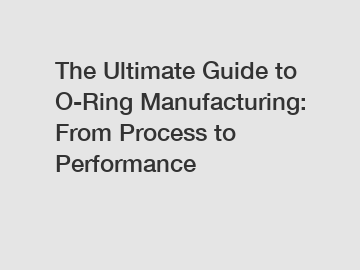The Ultimate Guide to O-Ring Manufacturing: From Process to Performance
The Ultimate Guide to O-Ring Manufacturing: From Process to Performance.
O-rings are integral components used in a wide range of industries, from automotive to aerospace. These small, circular seals are responsible for preventing leaks and ensuring proper sealing between two or more parts. While they may seem like simple rubber rings, the manufacturing process behind O-rings is precise and entails several steps. In this comprehensive guide, we will explore the process of O-ring manufacturing and shed light on the key factors that affect their performance.
Material Selection: The Foundation of O-ring Manufacturing.

The first step in O-ring manufacturing is the selection of the appropriate material. O-rings can be made from various materials, including rubber, silicone, fluorocarbon, and more. The material choice is crucial as it determines the O-ring's ability to withstand different temperatures, pressures, chemicals, and other environmental factors. Manufacturers carefully consider the application requirements before deciding on the material to be used.
Molding and Extrusion: Shaping the O-ring.
Once the material is selected, it undergoes either a molding or extrusion process to shape it into an O-ring. In the molding process, the material is heated and injected into a mold cavity under high pressure. Once the material solidifies, it is removed from the mold, resulting in a perfectly formed O-ring. On the other hand, extrusion involves forcing the material through a die to create a continuous profile. This profile is then cut into individual O-rings of the desired size.
Post-Curing: Enhancing Material Properties.
After molding or extrusion, the O-rings undergo a post-curing process. Post-curing involves subjecting the O-rings to elevated temperatures for a specific duration to enhance their material properties. This step helps to ensure that the O-rings possess the required elasticity, tensile strength, and resistance to environmental stress and chemicals.
Quality Control: Ensuring Performance and Reliability.
Quality control is crucial in O-ring manufacturing to guarantee performance and reliability. Manufacturers employ various testing methods, such as visual inspection, measurement of critical dimensions, and material property testing. These tests help identify any defects or deviations from the desired specifications, ensuring that only high-quality O-rings reach the market.
Performance Factors: Temperature, Pressure, and Chemical Compatibility.
The performance of O-rings is influenced by several factors, with temperature, pressure, and chemical compatibility being the most significant. O-rings must be capable of withstanding the temperature and pressure conditions they will be exposed to in their intended applications. Compatibility with chemicals, lubricants, and other fluids is also critical to ensure that the O-rings do not degrade or swell over time.
Application Considerations: Design and Installation.
Proper design and installation are important to maximize the performance and longevity of O-rings. Factors such as groove design, lubrication, and installation techniques play a crucial role in maintaining a reliable seal. Consulting with experts or referring to industry standards can help ensure that O-rings are correctly implemented.
In conclusion, O-ring manufacturing involves a careful selection of materials, precise shaping processes, post-curing, and rigorous quality control. Consideration of performance factors, such as temperature, pressure, and chemical compatibility, along with meticulous application considerations, contribute to the overall performance and longevity of O-rings. If you require high-quality O-rings or have any further inquiries, please do not hesitate to contact us.
If you are looking for more details, kindly visit Seals for Agriculture Equipment, blue tc rubber oil seal from china manufacturer, o'ring manufacturer.
203
0
0

Comments
All Comments (0)